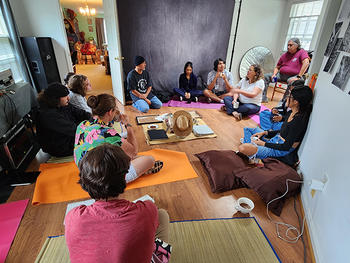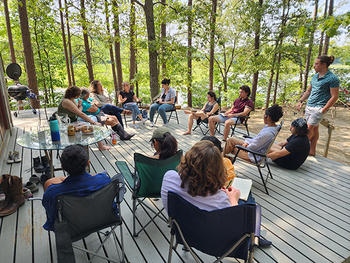Funded by the Office of the Provost, a project called “IndigenoUS Northern Virginia” brings together an interdisciplinary approach to increase knowledge and discussion of indigeneity, present and past in our region, created with the Center for Humanities Research (CHR) and the Roy Rosenzweig Center for History and New Media (RRCHNM), under the leadership of principle investigator Gabrielle Tayac, associate professor of history. During a three-week summer institute, students traveled around Northern Virginia, meeting with different communities and tribal members to learn about their role in the foundation and growth of Northern Virginia.
CHR is one of Mason’s five transdisciplinary research centers for advanced study. It was created in 2020 with support from the Provost’s Office and the College of Humanities and Social Sciences (CHSS).

Public administration major Nardi Soto Cordova registered for the summer institute because she has Indigenous ancestry, Quechua, and wanted to learn more “After meeting Quechua and Aymara people, I realized that traditions I've been involved with my whole life are, in fact, indigenous practices.”
As the university works to build communities and bring a sense of belonging for everyone, Tayac believes that bringing together Mason students and local tribal members and leaders will create sustainable connections across the community and region with indigenous communities.
Art history graduate student Sean Simmons, one of 12 summer students, described the “Circulo” led by Mason alum Juan Pacheco, coordinator of the East Coast chapter of Barrios Unidos. “I've never been in a learning environment that was simultaneously so welcoming and impactful,” he said.
Using public history methodologies and indigenous ways of knowing and being, the institute brings experiential and immersive learning to the understanding of the topics.
“It’s not just looking at old histories and understandings of the land that we live on and with, but also the living, vibrant communities that have continued, and looking at how our understandings of self in an intellectual community like Mason are intertwined,” said Tayac. “Knowing the people changes how you understand and share the history.”
Students shared meals, listened to stories, visited sacred sites, and engaged in traditions both on and off campus with local indigenous communities. On the summer solstice, the students meditated in the new garden beside Horizon Hall on George Mason University's Fairfax Campus, led by visiting Andean Indigenous leaders.

Domi Hannon, an Honors College student majoring in foreign languages, as well as a student leader of Mason’s Native American and Indigenous Alliance (NAIA), said understanding the indigenous landscape requires looking to the past in order to move forward.
The CHR hopes that the success of this institute will lead to future funding for public humanities projects. “Our methodology is based in what can we learn from communities, and what can we give back to communities,” explained Catherine Olien, project manager for IndigenoUS Northern Virginia and associate director of CHR. “Projects like this allow faculty, staff, students, and the community to learn from each other and grow together.”
In This Story
Related News
- July 28, 2025
- November 20, 2024
- June 11, 2024
- December 4, 2023
- October 9, 2023
